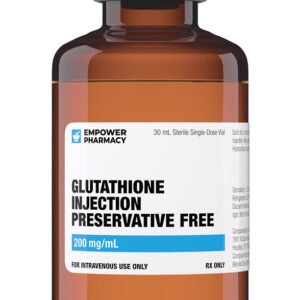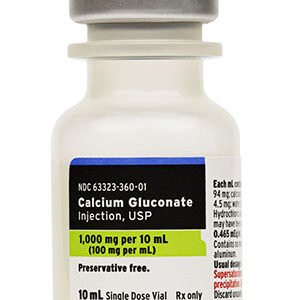Description
General Information
Thiamine, or vitamin B1, is a water-soluble vitamin found in such foods as yeast, cereal grains, legumes, peas, nuts, pork, and beef. Thiamine deficiency causes beriberi. Thiamine is also used to prevent peripheral neuritis associated with pellagra and pregnancy. This vitamin is also beneficial in treating metabolic disorders associated with subacute necrotizing encephalomyelopathy, branched-chain aminoacidopathy, and lactic acidosis associated with pyruvate carboxylase deficiency. Thiamine is considered a standard agent in the treatment of a patient with undiagnosed coma. Thiamine was approved by the FDA at its inception in 1938.
Mechanisms of Action
Thiamine combines with adenosine triphosphate (ATP) in the liver, kidneys, and leukocytes to produce thiamine diphosphate. Thiamine diphosphate acts as a coenzyme in carbohydrate metabolism, in transketolation reactions, and in the utilization of hexose in the hexose-monophosphate shunt. Without adequate thiamine, pyruvic acid does not undergo conversion to acetyl-CoA and cannot enter the Krebs cycle. Pyruvic acid accumulates in the blood and is subsequently converted to lactic acid, with the potential development of lactic acidosis. Diminished production of NADH in the Krebs cycle also results in lactic acid production through facilitation of anaerobic glycolysis.
Thiamine deficiency appears as a nonspecific syndrome: headache, nausea, malaise, myalgias. Severe thiamine deficiency causes beriberi. Beriberi can affect the cardiovascular system (wet beriberi) and the nervous system (dry beriberi and the Wernicke-Korsakoff syndrome). Cardiovascular manifestations include peripheral vasodilation, biventricular failure, and edema. Neurologic symptoms include neuropathy, ataxia, retrograde amnesia, impaired ability to learn, and confabulation. Once Korsakoff’s syndrome appears, thiamine supplementation is successful in only half of the patients.
Pharmacokinetics
Thiamine is administered orally and by intramuscular or intravenous injection. Thiamine is widely distributed. Body storage of thiamine is limited to about 30 mg. Thiamine is distributed into breast milk at a rate of about 100—200 mcg daily from normal dietary intake. There is little excretion of thiamine or its metabolites at physiologic doses. Following large doses, saturation occurs, with subsequent renal excretion as pyrimidine.
Route-Specific Pharmacokinetics:
Oral Route: Small oral doses are readily absorbed from the GI tract, but absorption of large doses is limited. Administration with food reduces the rate of absorption.
Intramuscular Route: Following IM administration of thiamine, vitamin B1, absorption is rapid and complete.
Special Populations:
Hepatic Impairment: Patients with cirrhosis have a decreased extent of absorption of thiamine, vitamin B1.
Alcoholism: Alcoholics have a decreased extent of absorption of thiamine, vitamin B1.
Malabsorption: Patients with malabsorption have a decreased extent of absorption of thiamine, vitamin B1.
Contraindications / Precautions
Wernicke’s encephalopathy may be precipitated or worsened if intravenous glucose is administered to a thiamine-deficient patient. Thiamine (vitamin B1) should be administered prior to glucose. Clinicians should note that parenteral glucose should never be administered to a comatose patient without the prior administration of thiamine.
Thiamine is classified as FDA pregnancy risk category A. Appropriate maternal thiamine (vitamin B1) intake is encouraged during pregnancy, and no maternal or fetal complications associated with maternal dietary intake or supplementation to achieve adequate intake goals have been reported. As with other water-soluble vitamins, the pregnancy risk factor increases to FDA risk category C if the vitamin is used in dosages exceeding the Recommended Dietary Allowance (RDA) during pregnancy.
According to the manufacturer, caution should be exercised when thiamine is administered during breastfeeding. However, while thiamine is excreted in human milk, appropriate maternal intake of thiamine (vitamin B1) is important during lactation, and no maternal or fetal complications have been identified with maternal supplementation to achieve adequate intake goals during breastfeeding. Seizures have occurred in nursing infants of mothers with thiamine deficiency, although causality has not been established. Supplementation with thiamine is recommended in lactating women whose diets do not provide adequate amounts of thiamine. The American Academy of Pediatrics classifies thiamine as compatible with breastfeeding. Consider the benefits of breastfeeding, the risk of potential infant drug exposure, and the risk of an untreated or inadequately treated condition. If a breastfeeding infant experiences an adverse effect related to a maternally administered drug, healthcare providers are encouraged to report the adverse effect to the FDA.
Pregnancy
Thiamine is classified as FDA pregnancy risk category A. Appropriate maternal thiamine (vitamin B1) intake is encouraged during pregnancy, and no maternal or fetal complications associated with maternal dietary intake or supplementation to achieve adequate intake goals have been reported. As with other water-soluble vitamins, the pregnancy risk factor increases to FDA risk category C if the vitamin is used in dosages exceeding the Recommended Dietary Allowance (RDA) during pregnancy.
Breastfeeding
According to the manufacturer, caution should be exercised when thiamine is administered during breastfeeding. However, while thiamine is excreted in human milk, appropriate maternal intake of thiamine (vitamin B1) is important during lactation, and no maternal or fetal complications have been identified with maternal supplementation to achieve adequate intake goals during breastfeeding. Seizures have occurred in nursing infants of mothers with thiamine deficiency, although causality has not been established. Supplementation with thiamine is recommended in lactating women whose diets do not provide adequate amounts of thiamine. The American Academy of Pediatrics classifies thiamine as compatible with breastfeeding. Consider the benefits of breastfeeding, the risk of potential infant drug exposure, and the risk of an untreated or inadequately treated condition. If a breastfeeding infant experiences an adverse effect related to a maternally administered drug, healthcare providers are encouraged to report the adverse effect to the FDA.
Adverse Reactions / Side Effects
Thiamine is relatively free from adverse reactions. The incidence of severe reactions to parenteral thiamine is estimated to be < 0.1%, even with undiluted IV push administration. In rare cases, thiamine hypersensitivity, including urticaria, anaphylactoid reactions, collapse, and death have occurred, primarily following repeated parenteral administration. Symptoms of sneezing or generalized pruritus may preceed more severe reactions. Pruritus appears to occur in approximately 1% of individuals receiving parenteral thiamine. There have also been reports of a feeling of warmth, urticaria, weakness, diaphoresis, nausea, restlessness, tightness of the throat, angioedema, cyanosis, pulmonary edema, and GI bleeding with parenteral administration.
The most common adverse reaction to parenteral thiamine administration is an injection site reaction. Pain, induration, and tenderness after IM injection can occur. Patients receiving IV thiamine may experience transient burning or pain immediately after injection into the IV site or IV line. Reactions related to IV thiamine administration can be minimized by slow IV administration into larger, more proximal veins with high flow rates. Injection site reactions are usually mild and transient, with no permanent consequence.
Storage
Store this medication at 68°F to 77°F (20°C to 25°C) and away from heat, moisture and light. Keep all medicine out of the reach of children. Throw away any unused medicine after the beyond use date. Do not flush unused medications or pour down a sink or drain.
Refrences
1Briggs GG, Freeman RK, Yaffee SJ. Thiamine. In: Drugs in pregnancy and lactation: a reference guide to fetal and neonatal risk. 8th ed. Philadelphia: Lippincott Williams & Wilkins: 2008;1792-3.
2Thiamine Hydrochloride injection package insert. Lake Zurich, IL: Fresenius Kabi USA, LLC; 2013 Oct.
3American Academy of Pediatrics (AAP) Committee on Drugs. Transfer of drugs and other chemicals into human milk. Pediatrics 2001;108(3):776-789.
4Wrenn KD, Murphy F, Slovis CM, et al. A toxicity study of parenteral thiamine hydrochloride. Ann Emerg Med 1989;18:867-70.






Reviews
There are no reviews yet.